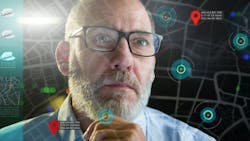The freight industry is uncertain, with fluctuations in the marketplace causing volatile rates and pushing some carriers to exit the market altogether. Yet, if there's one thing industry stakeholders can agree on, it's that technology and AI will play an ever-increasing role in the coming year.
"Everyone's talking about AI, but it's really using the machine learning side of AI. We're not talking large language models and all that type of thing, which is generative AI," Glenn Mitchell, head of product management at MiX Telematics, told FleetOwner. "We're talking about machine learning with pattern recognition, which enables us to predict what's going to happen and allows us to optimize the decisions that humans make around the activities in the fleet."
Machine learning is already used in fleets for applications such as optimizing routing, maintenance, and EV charging. Samsara's head of AI and data, Evan Welbourne, told FleetOwner he expects generative AI to be used more often, allowing even deeper insights.
"Moving into 2024, I anticipate a continuous maturation of generative AI technologies, particularly emphasizing domain-specific knowledge and real-time adaptation to evolving scenarios," Welbourne said. "This convergence of generative AI with domain expertise will facilitate more nuanced and valuable insights, making AI a quintessential partner in decision-making processes across industries."
Motive CCO Ryan Plutnicki told FleetOwner that the maturation of AI technology will lead to faster and more varied solutions for the company's fleet customers.
"The speed at which a customer can say, 'This is a critical problem that I'm trying to solve,' and Motive can turn around a solution that leverages video recognition artificial intelligence is increasing," Plutnicki said. "It's accelerating significantly."
Motive had a fleet customer that was using key fobs to match drivers to trucks. Due to the fleet's high turnover, it had difficulty distributing the key fobs efficiently, so Motive built a facial recognition solution to match drivers to trucks.
"We turned that around in a couple of months," Plutnicki told FleetOwner. "That was unheard of a few years ago."
According to Mitchell, not only will AI for current technologies such as dashcams and routing improve, but new use cases will also develop. Machine vision is used not only on vehicles but in the yard as well. Cameras could be installed to recognize whether a dock is available. Machine vision could also determine how much cargo is in a trailer and optimize trailer loading.
See also: FedEx tests Dexterity AI's robotic trailer loading tech
Breaking down data silos in trucking
Plutnicki said customers have told him that some fleet personnel have had to take on additional duties under the difficult economic environment of the past several months, such as safety officers who might now be needed to oversee productivity. This requires greater visibility and insight to be available from software tools.
"When I speak with our customers, they are often saying that they are the same people who had jobs that were siloed in one area are now wearing multiple hats," Plutnicki said.
One of the significant challenges Mike Hamill, SVP of strategy for Trimble Transportation, sees the industry working to overcome in 2024 is the process of data integration. Fleet data can come from ELDs, tire pressure management systems, GPS, and various aftermarket devices. Because of the disparate data sources, integrating that data into a platform where managers have a holistic view of operations is complex.
"Connectivity through integration and good data are probably the largest hurdles that I see," Hamill told FleetOwner. "We're working internally to not only make our products better together, but they have to play well with other vendors and even competitors in the market.
Hamill predicted that, as data measurements become standardized, there will be more collaboration and interoperability between device manufacturers.
Samsara CIO Stephen Franchetti told FleetOwner: "As the AI explosion continues, an organization's ability to stay competitive and innovate will come down to their enterprise data strategy. We'll start to see an increased need for a robust foundation of reliable and well-governed enterprise data. Utilizing the power of this data is paramount for training precise machine learning models, deriving insightful analytics, and enabling intelligent decision-making."
About the Author
Scott Keith
Scott Keith is a former fleet owner digital editor, who was on staff from 2022 to 2023.

